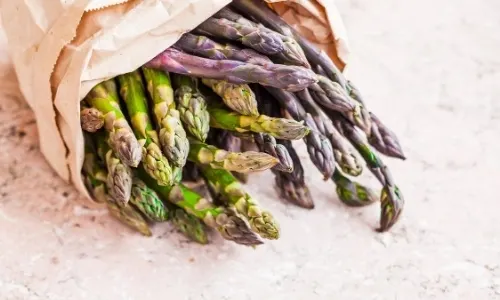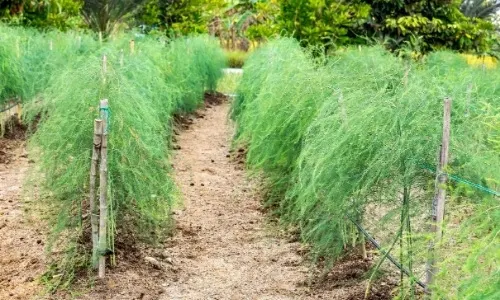Asparagus is one of those vegetables that has been around since practically forever. There are ancient roman manuals on how to grow and harvest asparagus, if you can believe.
But is asparagus roman ? Where did asparagus first appear ?
And how did we get to the asparagus we know today, and where does that one from ?
This is what we’re going to find out today.

Where did asparagus first appear ?
Asparagus seems to originate from the basins of the Tigris and Euphrates river, in the Middle East. There are records of Greek, Egyptian, Roman, and Persian use of asparagus as old as 3000 B.C.
The word for asparagus is derived from ancient Persian ‘asparag’, meaning ‘young shoot’.
Over time it was mainly cultivated along the Mediterranean Basin, so Italy, Spain, Greece, North Africa all became common growing places for asparagus.
As a result of this, it’s often thought that it’s an ancient roman vegetable. In truth, asparagus is much older than that.
This is an ancient Persian vegetable, but it may have sprouted on its own in parts of Europe close to the Asian continent.
It found its way into India as well, and is now mostly grown in China.
Read Also:Prickly Pear Substitute
Asparagus is not related to bamboo, the confusion comes from the lucky bamboo(dracaena sanderiana) that is indeed part of the Asparagaceae family which is the main family for asparagus but the lucky bamboo is not bamboo. There are a lot of species of bamboo but lucky bamboo is not one of them.
Bamboo is part of the subfamily Bambusoideae which has nothing in common with the Asparagaceae family other than this little confusion.
Green, white, and purple asparagus
As time went on, asparagus became considered a delicacy, or an expensive food item.
The classic green asparagus we all know and love was the only one for a very long time.
It was used in several ways, including as an offering in Egyptian and Roman offerings, as an aphrodisiac, as a medicinal plant, and simply as a meal.
In time, white asparagus became available. This happened because folks started piling mulch and dirt on top of the growing asparagus spears.
This meant no sunlight would touch the spears, and thus they wouldn’t turn green.
There isn’t much of a difference between white and green asparagus, in terms of flavor, but it’s definitely eye-catching.

Then there is purple asparagus. You may have noticed the tips of green asparagus turning kind of purple.
Well, a region in Italy (Albenga) has produced purple asparagus, from head to toe. It’s not purple on the inside, as only the outside is purple.
It will lose its color if cooked for too long, and it’s much more tender and sweet so it can be eaten raw.
Asparagus is closer to flowers than broccoli
As much as asparagus may remind you of broccoli, Brussels sprouts, or kale, it’s actually nowhere near those plants.
Asparagus has had a wild ride in terms of classification, but in short it’s closer to the flower type plants than cruciferous vegetables.
What kind of flowers ? Well, the kind that are somehow related to the lily, but very distantly.
Asparagus is its own family, and when you see a fully grown plant you’ll notice it’s very different from the shoots we eat today.
Much like bamboo shoots are very young bamboo plants, asparagus shoots are very young asparagus plants.
Let them grow any bigger and they turn into a woody, inedible plant that can’t really be used for much.
In fact, a fully grown asparagus plant looks like a very thin and messy pine tree, with seeds growing on the thin branches like very small pine cones.

fully grown asparagus plant
Where does asparagus come from today ?
Nearly all asparagus in the supermarket and shops today is from China.
If you’re from America, then the story may be very different. There asparagus is grown domestically, with the major producers being California, Washington, and Michigan.
As asparagus needs lots of land to grow, and America has plenty of it, it makes sense to grow it locally and send it all over the country.
The only problem is that, despite being grown domestically, even American asparagus ends up being expensive.
The main reason is the very long wait time (think years) for the shoots to peek through the soil, and the fact that you can’t use that land for anything else.
Not only is it occupied by asparagus, but it also need a high salinity to thrive and keep weeds at bay.
When you think about it that way, all those snapped asparagus ends wind up seeming wasteful. They can be used too, they just need more care.
Despite growing its own, America is still the largest asparagus importer (2016), importing as much as 214,735 tonnes of asparagus per year.
Read Also:Best Sweet Rice Flour Substitutes (Gluten Free)
Asparagus is often imported in Europe and Asia
If you’re Europe or Asia (or just not America) then your asparagus is most likely from China.
China produces the vast majority of the total asparagus crop – about 7,845,162 tonnes in 2017.
Next come Peru and Mexico, then America, and then Germany, though its main asparagus crop is white asparagus.
As such, asparagus prices tend to be a little higher, since there is a lot more import going on.
If you want to be really sure, you should check the label on the asparagus. You should find the country of origin label on the side.
All in all, asparagus is a great vegetable that goes well with pretty much anything. It’d be a shame to miss out on at least one serving, simply due to its price tag.
Conclusion
We found out that the asparagus originates from the Middle East and many important empires have used this vegetable. We also cleared out the confusion between the bamboo and asparagus relationship.
I hope this article helped you and now you know the origins of this incredible plant and you will try to include asparagus more often in your diet since is a very nutritious vegetable.

